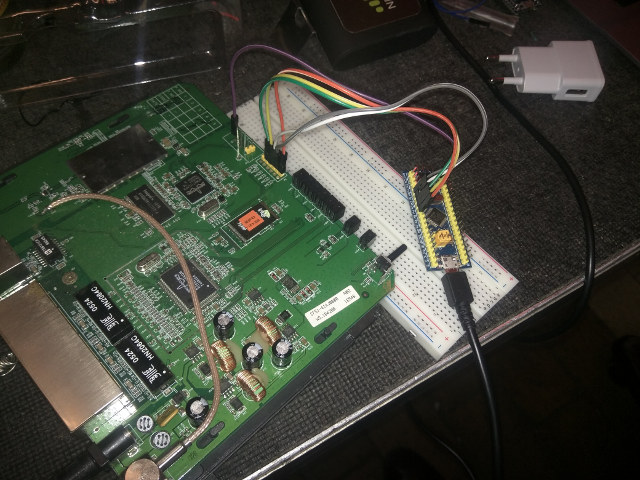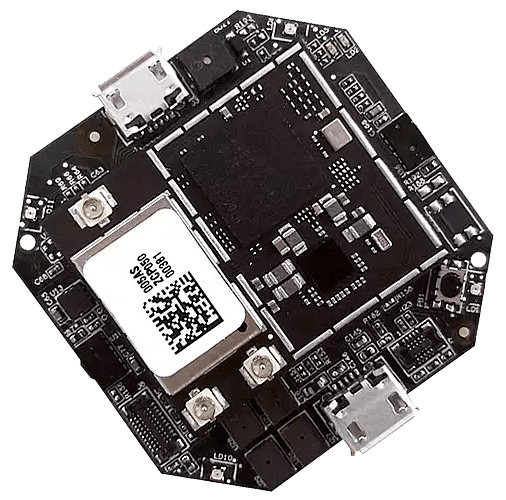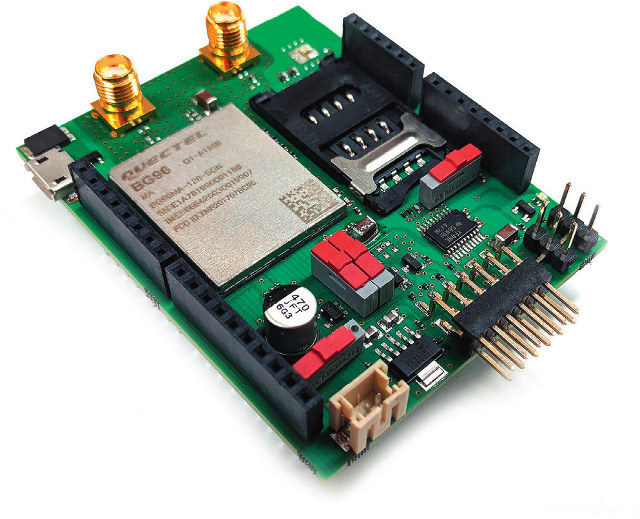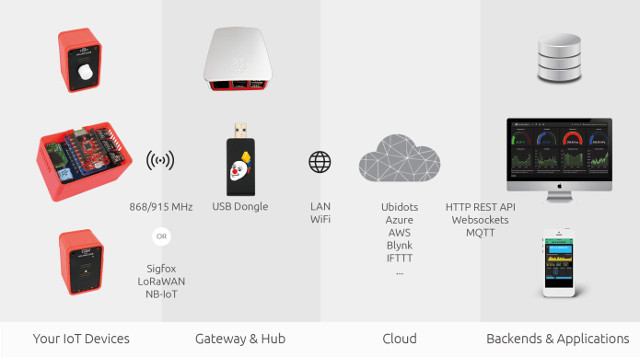DirtyJTAG is a JTAG adapter firmware for cheap STM32 boards like BluePill or equally inexpensive ST-Link V2 clones that was developed to create an alternative to the cheap – but now obsolete – LPT Wiggler cables, and more expensive USB JTAG probes. You’ll find the source, and documentation on Github. First, you’ll need to flash the firmware using the DFU method or an SWD programmer (for ST-Link) or USB to TLL debug board (for STM32 dev boards), before making the connection to the target board as shown below (for Bluepill). STM32 JTAG PA0 TDI PA1 TDO PA2 TCK PA3 TMS PA4 TRST PA5 SRST You can then use mainline UrJTAG for your newly flashed JTAG adapter. If you prefer OpenOCD, it might eventually be possible to use Versaloon firmware instead on STM32 Bluepill board. Thanks to Zoobab for the tip. Jean-Luc Aufranc (CNXSoft)Jean-Luc started CNX Software in 2010 as a […]
RushUp KITRA Board Family is based on Samsung Artik 020, Artik 520/530, or Artik 710 Modules
Samsung first announced their Artik IoT modules almost three years ago, and until recently most Artik related products or development kits came from Samsung themselves, with no third party involved. But this has started to change recently with announcements such a Seeed Studio Eagleye 530s low cost development board based on Artik 530 module, and Resin.io Project Fin combining RPI CM3L module with an Artik 020 module for low power Bluetooth connectivity. But as I flicked through Resin.io supported hardware, I discovered they also supported Linux powered Artik 520 and Artik1020 module, as well as some new “KITRA” boards I had never heard of, and if we visit RushUp company website, we can see they have a bunch of Kutra boards and one IoT gateway based on Artik modules: KITRA 520 – Samsung ARTIK 520 product accelerator for advanced IoT KITRA 710 – Samsung ARTIK 710 product accelerator for advanced multimedia […]
Avnet Silica NB-IoT Sensor Shield Works with mbed OS 5, STM32 Nucleo Board
If for some reasons, none of the many NB-IoT boards launched recently suit your needs, there’s yet another option with Avnet Silica NB-IoT sensor shield, that supports – despite the name – also supports LTE Cat M1 (eMTC) beside NB-IoT (LTE Cat NB1), and comes with Arduino headers, as well as a Pmod connector. The board relies on Quectel BG96 module, and can be controlled with Arm mbed OS 5 when connected to STM32 Nucleo board. NB-IoT Sensor Shield specifications: Cellular Module – Quectel BG96 LPWA Module Multi Modes: Cat.M1, Cat.NB1, EGPRS Global bands Cat M1/NB1: B1 B2 B3 B4 B5 B8 B12 B13 B18 B19 B20 B26 B28 B39 (B39 for Cat M1 only) EGPRS: 850/900/1800/1900 MHz Voice Over LTE support (M1 only) – PCM digital audio interface SIM card holder (also optional embedded SIM) Optional GNSS – GPS, GLONASS, BeiDou/Compass, Galileo, QZSS Expansion – Arduino headers, Pmod connector […]
STMicro STM32WB Dual Core Cortex M4/M0+ MCU Comes with Bluetooth 5 & 802.15.4 Radios
STMicro has announced yet another family part of their STM32 portfolio with STM32WB micro-controller family featuring an Arm Cortex M4 application core, a Cortex M0+ core to offload the main core of networking tasks, as well as Bluetooth 5 and 802.15.4 radios. The MCU’s 802.15.5 radio can run other wireless protocols concurrently, including OpenThread, ZigBee, or proprietary protocols used to connect devices to the Internet of Things (IoT). STM32WB MCUs share the following key specifications: Application Core – Arm Cortex-M4 CPU @ up to 64 MHz with FPU, adaptive real-time accelerator (ART Accelerator), MPU, 80 DMIPS and DSP instructions Memory – Up to 256 KB RAM, including 64 KB with hardware parity check, 20×32-bit Backup Register Storage Up to 1 MB Flash with sector protection (PCROP) against R/W operations for Bluetooth Low Energy and 802.15.4 SW stack Quad SPI memory interface with XIP Radio 2.4 GHz RF transceiver supporting Bluetooth […]
STMicro Introduces Two STM32 Discovery Kits with 2G/3G or 4G LTE-IoT Cat M1/NB1 Connectivity
Embedded World 2018 trade fair will take place on on take place on February 27 – March 1 in Nuremberg, Germany, and we’re starting to see some company announce new products and solutions for the embedded market. STMicro has just announced their showcase their very first cellular development kits at the event, based on a display-less variant on their 32L496GDISCOVERY Discovery board with cellular add-on boards: P-L496G-CELL01 Discovery kit with with a 2G/3G modem P-L496G-CELL02 Discovery kit with with an LTE-IoT Cat M1 (eMTC) / NB1 (NB-IoT) / 2G model Now the company has not started designed their own cellular modem, but instead relying on QUECTEL modems. Both kits share most of the same specifications: MCU – STMicro STM32L496AGI6 Arm Cortex M4F MCU@ 80 MHz with 1 MB Flash, 320 KB RAM in a UFBGA169 package On-board memory – 8 Mbit PSRAM On-board + external storage – 32 KB I2 […]
Getting Started with TinyLIDAR Time-of-Flight Sensor on Arduino and Raspberry Pi
TinyLIDAR is an inexpensive and compact board based on STMicro VL53L0X Time-of-Flight (ToF) ranging sensor that allows you to measure distance up to 2 meters using infrared signals, and with up to 60 Hz. Contrary to most other VL53L0X boards, it also includes an STM32L0 micro-controller that takes care of most of the processing, frees up resource on your host board (e.g. Arduino UNO), and should be easier to control thanks to I2C commands. The project was successfully funded on Indiegogo by close to 600 backers, and the company contacted me to provided a sample of the board, which I have now received, and tested with Arduino (Leonardo), and Raspberry Pi (2). TinyLIDAR Unboxing I was expecting a single board, but instead I received a bubble envelop with five small zipped packages. Opening them up revealed three TinyLIDAR boards, the corresponding Grove to jumper cables, and a bracket PCB for […]
BigClown is a Battery Powered Modular Wireless IoT Kit for Makers (Crowdfunding)
BigClown IoT Kit is designed to be as easy to use as building a castle from LEGO bricks or an IKEA cabinet. The open source kit is comprised of a coreboard module with STMicro STM32L0 Cortex M0+ micro-controller, and a sub GHZ (868/915MHz) radio for wireless communication, that accepts one or more compatible modules (currently ~30 different options), and communicate to a gateway such as Raspberry Pi or Turris Omnia where you’d connect BigClown RF USB dongle, although it’s also possible to include a Sigfox module for communication, and , LoRa & NB-IoT module appear to be planned. That’s for the hardware…The kit then connects to your chosen gateway via MQTT, which in turns accesses cloud services such as Ubidots, Microsoft Azure IoT, AWS, IFTTT, etc… , and you can monitor the data or control the kit through a web based dashboard or your own application. Core Module specifications: MCU […]
Pulurobot is a Low Cost Open Source Raspberry Pi based Load Carrying Autonomous Robot
Earlier today I wrote about FOSDEM 2018 schedule, and among the various talks I selected for my virtual schedule was “How to build an autonomous robot for less than 2K€”. Some excerpt from the abstract including a short description of the project, and its “open-sourceness”: PULUrobot solves the autonomous mobile robotics complexity issue without expensive parts, without compromise. By fearless integration and from-scratch design, our platform can do SLAM, avoid obstacles, feed itself, and carry payload over 100kg, for less than 2,000 EUR. Application ecosystem can be born around it, as we offer a ready-made Open Source (GPLv2) solution in a tightly coupled HW-SW codesign. So I decided to have a closer at this project, which can be used as a robot maid/helper of sort, and other applications. The robot was made by a brand new (July 2017) startup called Pulu Robotics Oy and based in Finland. They have three […]










